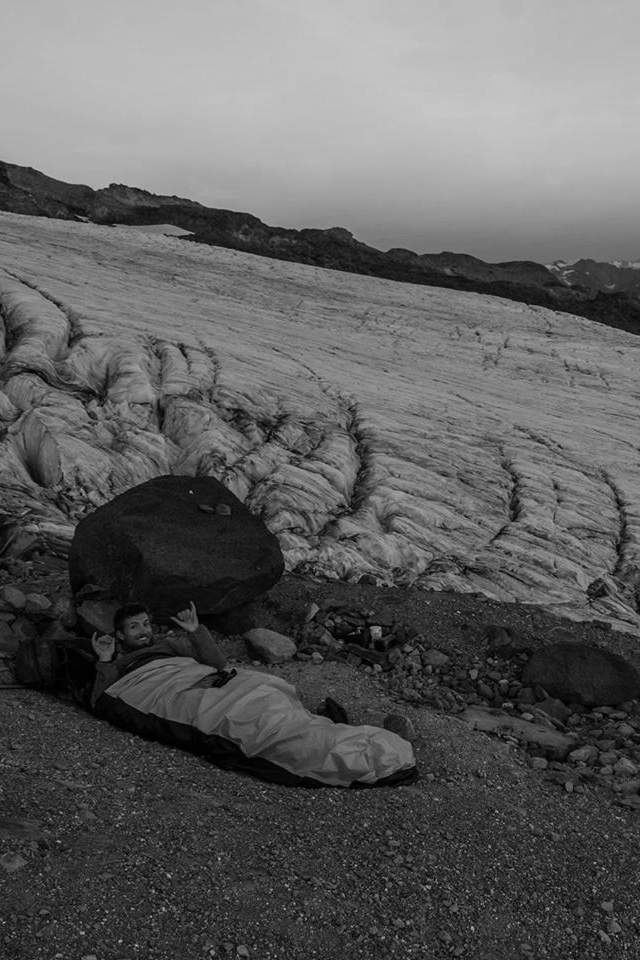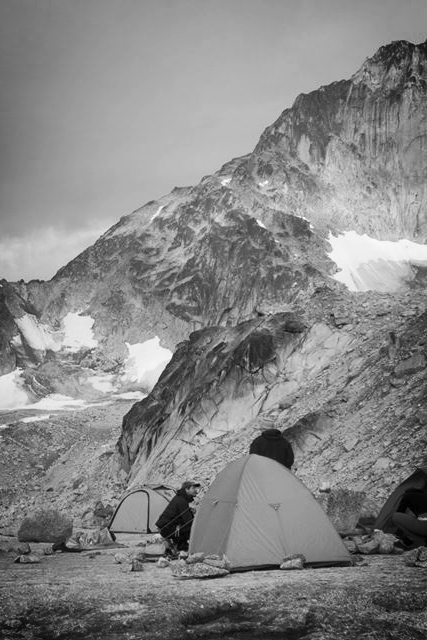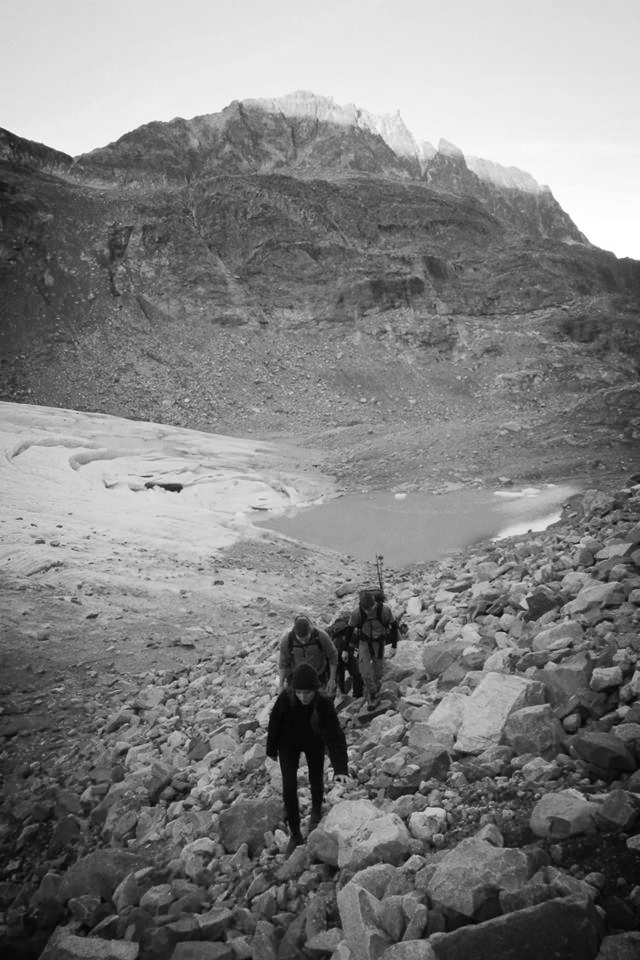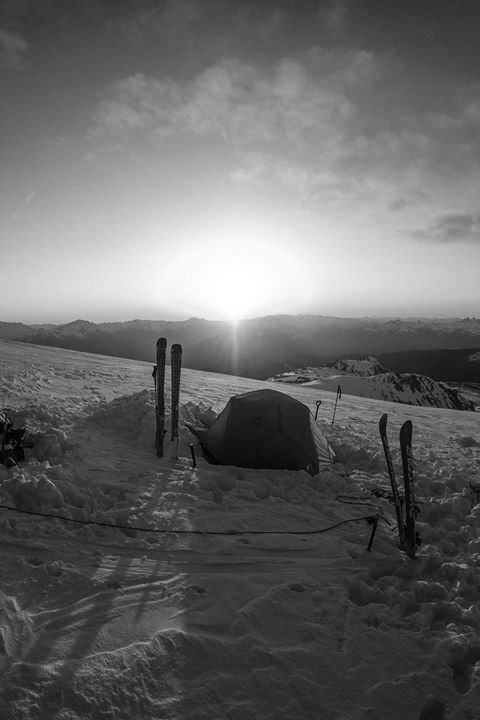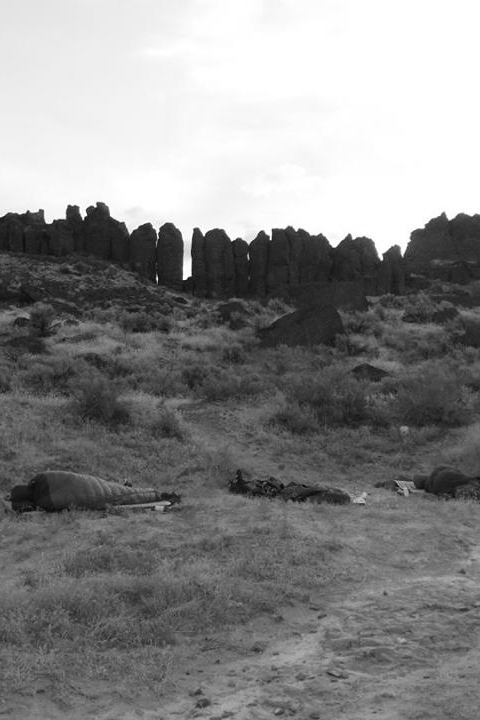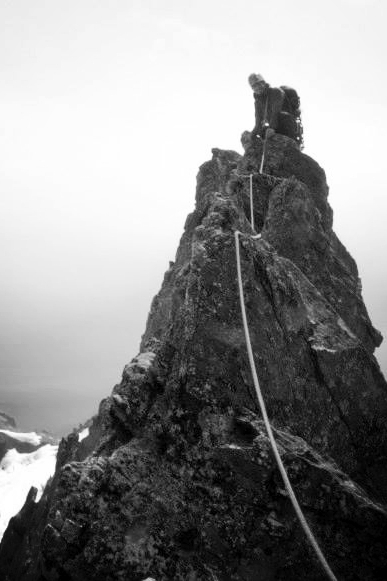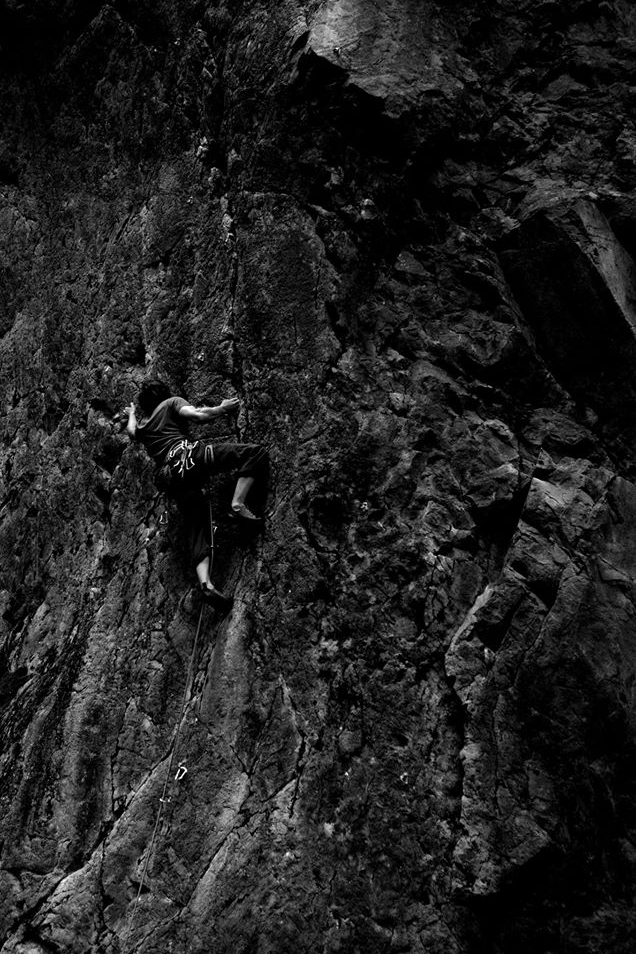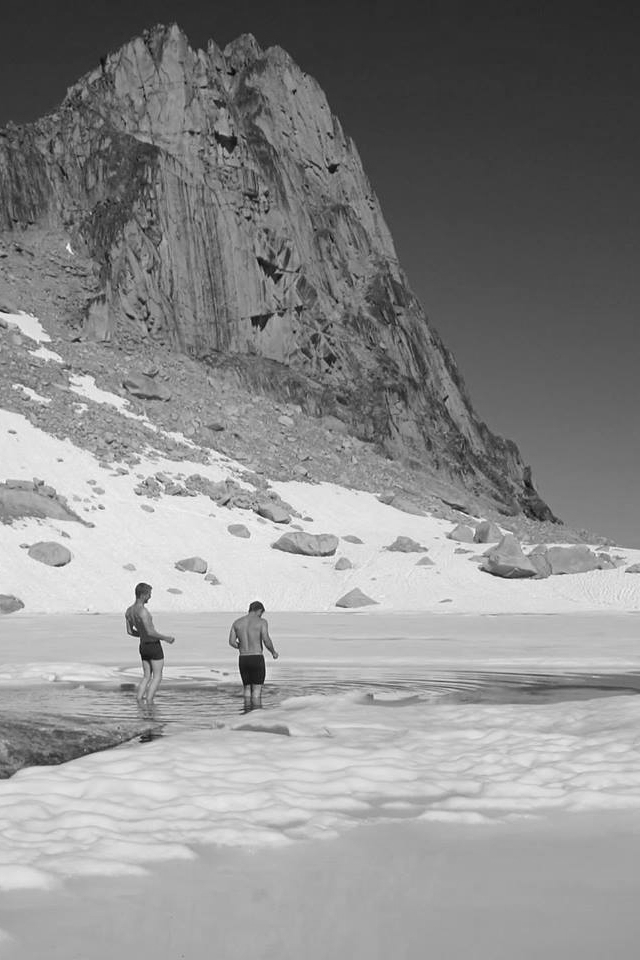The KLR fired up with little heartache in early March of 2020. It had been sitting in a sublet apartment’s yard for several winter months of rain while I was up north for work. The once knobby tires were bald and the cam chain rattled more than I remembered. I changed the oil, filters, and rode it around Victoria for a few months, reacquainting myself with its overly loud thump. I’d ride out to Elk and Prospect Lake to fly fish for trout and hum up the Foul Bay Road hill to volunteer at the University of Victoria.
Come early May I had moved into a friend’s place in Nanaimo. Covid-19 got me off work and gave me an opportunity to focus on hobbies. I put together a fly rod, gun locker, squatty potty, and literal truck bed before replacing the exhaust on the Taco and turning my attention to the KLR. I spent two months living alone on Wakesiah Avenue knowing an old friend, Robyn, and her boyfriend would move in for July. I was nervous about living with folks considering Bonnie’s social distancing guidelines, but it would more than pan out. I’d reconnect with a friend from my early twenties and meet Luke — now a great friend who inspired me to go on this trip.
They pulled up in a tiny, red Ford Festiva as I stood on the porch holding a cup of coffee looking down at the motorbike in the drive. Over the next month or so Luke and I would spend entire days tinkering on various projects before trolling for rainbow trout and kokanee in the evening. We would chat to pass the time and I’d hear of his ~4000 km canoe trip from the Rockies, down the Athabasca and Mackenzie, and into the Arctic Sea at Tuktoyaktuk in the Northwest Territories. “Fuck, that is wild,” I’d tell myself repeatedly upon hearing and later thinking about his experience. I grabbed my tablet, opened everyone’s favourite search engine, and dove into the wormhole. Something like a half-hour later and I had decided that I was going to the Arctic.
I replaced the Eagle Mike raising links with a stock pair I had salvaged for free by hanging the back end of the KLR from a tree branch in the yard. Put on cheap tires (Shinko 244s) and swapped out the fouled spark plug, worn chain, battery, and OEM footpegs. I also cleaned the carburetor, added handguards, bought a pair of used soft panniers for $60, swapped the countershaft sprocket for a 16-tooth, and shimmed the carb needle with a single brass washer. But most importantly, and with some sarcasm, I did nothing about the famous “doohickey” (also known as a balancer chain adjuster lever) or valve clearances — as far as I know, neither has ever been serviced. I did, however, try to adjust the doohickey, which makes me laugh in hindsight.
The couple of days leading up to my departure were spent fishing and preparing the bike. Luke helped me fabricate an aluminum rear wheel guard to prevent my cheap soft panniers from getting shredded, signing his initials “L.S.” on the guard reluctantly in Sharpie. Also, I finally tackled a sewing project that I’d put off for nearly three years… in fifteen minutes. I threw together a crude but very comfortable and lightweight Thermarest cover — an item I now consider essential — out of bamboo cloth and a few feet of elastic ribbon. It is very soft, packs small, and serves as a fitted sheet when using your sleeping bag as a quilt. With that done, I packed all my gear into the panniers, top box, tank bag, and a 20 L dry bag. I’d bring all the normal lightweight tripping gear, plus a motorcycle repair kit, heavy rain gear, work laptop, and steel-toed Blundstones — I planned to stop in Chetwynd for a two-week shift.
NANAIMO TO FORT ST JOHN (1350 km)
I loaded the KLR on the morning of July 4 and with a quick goodbye, rode out to catch the Departure Bay ferry to Tsawassen. Motorcycles are loaded first, meaning you can show up ten minutes before departure and be guaranteed a spot on the next crossing. As usual, there is a pack of motorcycles parked at the end of terminal Lane 1 -- a few dual sport motorcycles scattered in a pack of cruisers. Taking the ferry with a motorbike is one of my favourite parts of touring. Mostly because everyone is amicable, chatty, and oddly supportive. Grabbing the tallest chock I can find, I wedge it underneath the skid plate to prevent the bike from falling over as we cross the Strait of Georgia. The tank bag comes off, the Crocs go on, and I head up to an outdoor seating area to read Predator's Prey, a book about Warren Jeffs and the Fundamental Church of Latter-day Saints -- a couple of Larabars and a Macintosh apple make the book's contents a little more digestible.
I once rode my first bike, an '82 Honda Magna, from Ottawa to Halifax overnight (1500 km in 16 hours or so) during a rainstorm. To make matters worse, and more entertaining in remembering, I was wearing a pair of old Cabelas hikers, black Levis, and an army surplus wool sweater underneath a Marlboro denim jacket. I had made it into New Brunswick by daybreak and stopped at a Timmies for a coffee and cigarette. Sitting on the curb in the empty parking lot, water draining from my boots, four sixty-something bikers approaching me. I look past them at a row of Harleys before eyeing their matching leather vests and white beards. They weren't giving anything up either; gruff faces and hard eyes, not saying a word -- even after they had stopped roughly ten feet away. One of them lifts his arm and points at my motorcycle. "Is that your bike?" I tell him so and that I had ridden from Ottawa. He pauses and two of them cross their arms. Unexpectedly, he looks at me and cracks a big smile, "We all had Magnas when we were your age! It's great to see a young guy riding one." All four start laughing and start looking at the motorcycle more closely, asking me about the ride. This kind of interaction still happens to me frequently and I really enjoy it.
I chose to ride the Trans-Canada from Vancouver to Cache Creek (Highway #1, 345 km) before continuing north along the Cariboo (Highway #97). This is one of my favourite stretches of road in the province. Not only because it's scenic, quiet, and winding, but because you traverse many biogeoclimatic zones in one day -- up to eight or nine, from what I understand. Essentially, you go from wet coastal rainforests (mountains with tall cedar, Doug fir, and alpine views), through cowboy country (rolling hills of ponderosa pine and bunchgrass), into the rolling boreal forests of central British Columbia. This may be my favourite major route north, but the Coquihalla and Sea to Sky are worth a pass as well -- I write of my route south and the Sea to Sky (Highway #99) further down. But I've got to say, riding along the Fraser River and watching the landscape transform around you is a special experience. And between the arid pine-covered hills surrounding Lytton, you can watch the Thompson mix into the turbid waters of the Fraser River.
<insert picture from google earth>
There is a little provincial park named Goldpan roughly 25 km NE of Lytton along with Highway #1. It is a long and narrow park built into the riverbank of the Thompson adjacent to the highway. It is not what I’d call picturesque as this makes it quite noisy, mostly due to trains across the water, but it is a practical choice for those trying to put in long days. The park offers riverside campsites and well water for the usual fee of $20 per night. Lucky for me, a kind stranger's pal bailed on their trip, causing him to offer me one of the two sites he had reserved and the last site in the park. I set up my sister's old MEC Tarn 2 and began making dinner when an older man approached me in the dark. He was holding a Tupperware and placed it at the end of my site's picnic table. "My wife made some delicious macaroni salad, and we would like you to have some," he says, "Just bring us the container and fork when you're done with it. Hell, keep them if you want." I ate all two thousand calories-worth of macaroni, Miracle Whip, mild cheddar, and chopped celery. I used the water I had boiled for tea and returned their cookware before heading to bed. It seemed as though trains rattled northward all night long, their whistles keeping me up and echoing in the canyon.
A night of bad sleep makes getting out of bed that much easier. I get up and go down the usual pre-departure checklist at 6 AM: topped up the oil, checked tire pressures, packed and secured my bags, and checked the weather. Thankfully, I charged my wireless earbuds overnight using a Li-ion battery pack expecting a long day of country music over grassy hills. The elderly couple waved goodbye as I rode towards the park's exit, taking a left onto the Trans-Canada towards Cache Creek as I sing along to Randy Travis' Deeper Than the Holler. There stratified and colourful exposed soils above the western banks of the river and Murray Creek Falls outside the small town of Spencer's Bridge make this stretch quite scenic. From there, Highway #1 follows the meandering Thompson to Cache Creek.
A couple of hours later and I pull into Cache Creek, home of the least bad Subway restaurant in Canada. Yes, even with the characteristic smell of bagged onion and green pepper, this location is somehow a great place to eat a sandwich while you sit on a parking block. It may have something to do with the fact that it is attached to someone’s actual home, that it has never served more than two people at one time, or that it still features its retro 90’s furnishings? I cannot be sure, but I can say that I've had about fifteen Subway gift cards at the bottom of my tank bag for over a year now. I threw them into my bike panniers thinking I'd use them on a bicycle tour of the Sunshine Coast — nope, kept opting for that Uncle Ben's instead. If only their other locations were more like that one…
Cache Creek is where you leave the Trans-Canada and head north on the Cariboo (Highway #97). The landscape gets less brushy and the road straightens out after you pass through Clinton, a small town with a welcoming main street and antique shops. Places to see along this stretch include the Chasm Ecological Reserve and Green Lake. The former is a 600-meter wide, 300-meter deep, and eight-kilometre long geological feature produced by glacial melt some 10,000 years ago. And, as you might expect, the water in Green Lake is a vibrant turquoise colour — a good spot to camp or take lunch. I had passed the lake turnoff when I drove through about 500 meters of what must have been at the time the hardest rain I've ever ridden in. Usually, on a motorcycle, you can see the weather coming from quite a distance, but I remember this catching me completely off-guard; I spotted wet pavement just ahead, and then raindrops the size of marbles began spattering against my windscreen. Thirty seconds later and we were back to clear skies and driving into 100 Mile where I'd grab a Tims and honey cruller while my jacket dried in the sun. I realize details like this aren't all that exciting to the reader, but it jogs my memory. Plus, it was a taste of what I’d get two weeks later in the Yukon.
A night of constantly interrupted sleep makes getting out of bed that much easier. I get up and go down the usual pre-departure checklist at 6 AM: topped up the oil, checked tire pressures, packed and secured my bags, and checked the weather. I charged my wireless earbuds overnight using a Li-ion battery pack expecting a long day of country music through bunchgrass hills. The elderly couple waved goodbye as I rode towards the park's exit, taking a left onto the Trans-Canada towards Cache Creek as I sing along to Randy Travis' Deeper Than the Holler. There stratified and colourful exposed soils above the western banks of the river and Murray Creek Falls outside the small town of Spencer's Bridge make this stretch quite scenic. From there, Highway #1 follows the meandering Thompson and dry rolling hills to Cache Creek.
A couple of hours later and I pull into Cache Creek, home of the least bad Subway restaurant in Canada. Yes, even with the unique smell of bagged onions and green pepper, it is somehow a great place to eat a sandwich while you sit on a parking block. It may have something to do with the fact that it is a frontage to a residential home, has never served more than two people at once, or features its retro furnishings? I've had about fifteen Subway gift cards at the bottom of my tank bag for over a year now. I threw them into my bike panniers thinking I'd use them on a bicycle tour of the Sunshine Coast but kept choosing plain Uncle Ben's instead.
From here, you leave the Trans-Canada and head north on the Cariboo (Highway #97). The landscape gets less brushy and the road straightens out after you pass through Clinton, a small town with a welcoming main street and many antique shops. Places to see along this stretch include the Chasm Ecological Reserve and Green Lake. The former is a 600-meter wide, 300-meter deep, and eight-kilometre long geological feature produced by glacial melt some 10,000 years ago. And, as you might expect, the water in Green Lake is a vibrant turquoise colour -- it is a good spot to camp or take lunch. I chose to stop at Timmies in 100 Mile House to dry off my riding jacket after a sudden downpour just N of Green Lake.
I continued to ride north along the Fraser River, cruising through William's Lake and Prince George, electing to stop at Bear Lake for the night. Crooked River Provincial Park (also known as Bear Lake) is located just off Highway #97 and most of the campsites were occupied when I arrived on the evening of July 5. There are many waterfront campsites and a sandy beach on the north side of the lake. I had ridden about 570 km at roughly 100 km/hr and was a little saddlesore despite the homemade highway pegs and MadDog seat cover. As usual, my first ten minutes making camp were spent changing into my military fleece pants and crocs, setting up the tent, and boiling water. I had a new favourite for dinner: parboiled rice risotto — cheap, tasty, and an easy pot to clean. I'd fall asleep to my three 20-something-year-old neighbours gossiping about their hot boy crushes, Kyle and Dylan, and how they weren't living up to the girls' standards. They giggled a lot and I couldn’t help but lie in the dark smiling for the better part of an hour.
Aside from two minutes of rain south of 100 Mile, bluebird weather accompanied me halfway across BC. I woke up the following morning, had a coffee, left Crooked River, and sped past the Mackenzie turnoff. The Pine Pass was sunny and clear, there were several canoes on Azouzette Lake, and it appeared as though a worker camp was set up at Powder King. A couple of hours of scenic and twisty riding and I’d pull into Chetwynd, ready for a shift at work. I parked the motorcycle in the shop, hopped into a company truck and drove up the Don Phillips Highway. A school friend, Julian, has been building a cabin that overlooks the Moberly River just downstream of the lake's outflow. I look up at it as I ride across the short bridge; tarps still cover the roof and I look forward to visiting in the future. I pass Moberly Lake and Cameron Lakes, cross the Peace River just downstream of the Peace Canyon Dam and enter the small community of Hudson's Hope.
The 1,150-person town of Hudson's Hope is located on the north bank of the Peace River just downstream of the Peace Canyon Dam (Site B) and roughly 60 kilometres upstream of the Site C Dam worksite. The section of river connecting Fort St. John and Hudson’s Hope will be impounded upon the completion of Site C come the summer of 2021. A great deal of the Peace River Valley will be lost to the dam, and many of its long-time inhabitants are being forced to move. The valley is composed of particularly valuable agricultural land given its fertile soils and ability to concentrate what little sunlight it collects during the spring and fall, effectively extending the growing season. Valuable habitat and environmental features will be destroyed, too. This includes Watson Slough, a wetland conservation project and stop-over for migratory birds, and several large tufa seeps, calcium carbonate formations that host rare plant and algal species as a result of the warm and nutrient-rich groundwater they expel.
[TO BE FINISHED]
FORT ST. JOHN TO THE ARCTIC CIRCLE
ARCTIC CIRCLE TO NANAIMO

